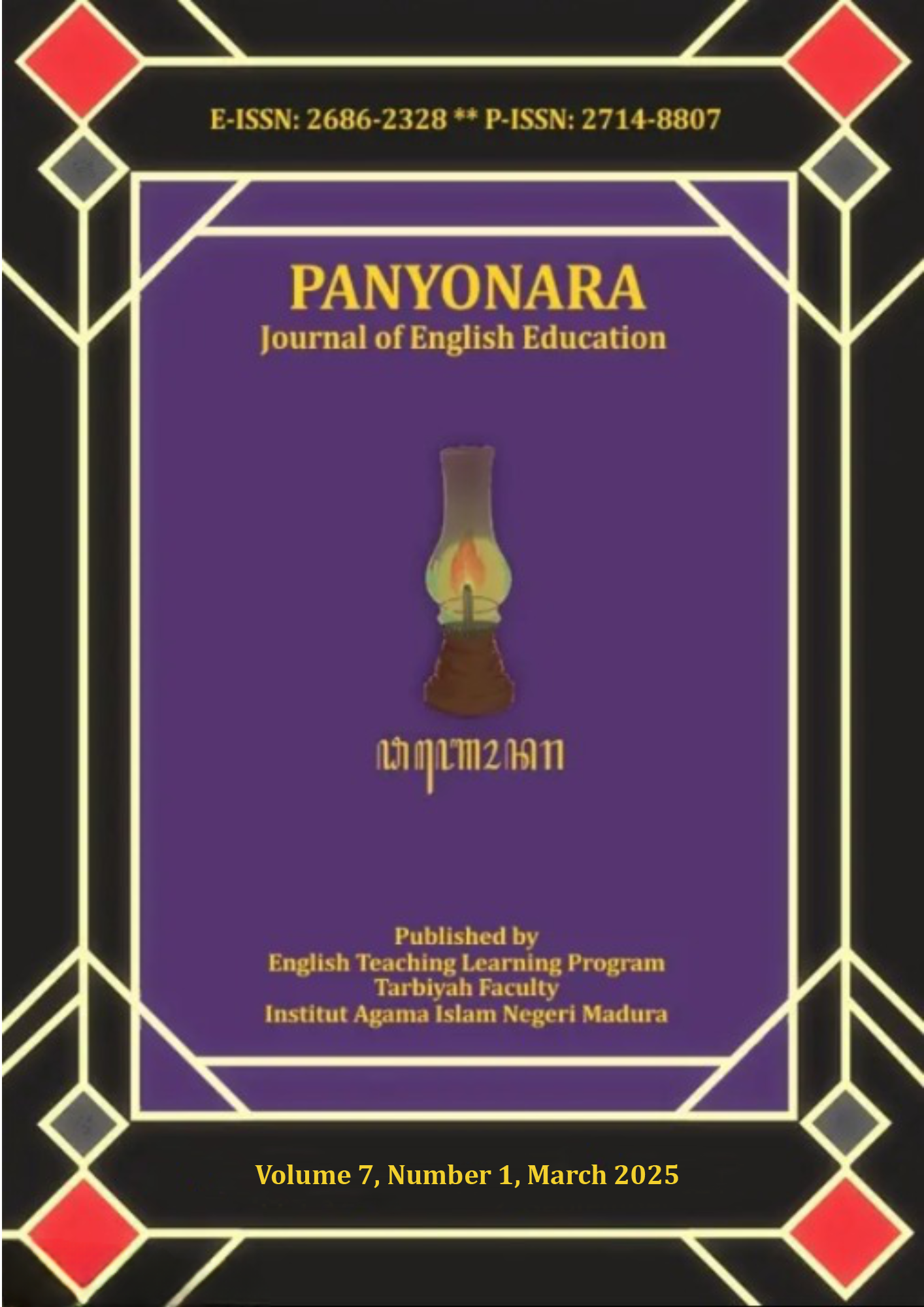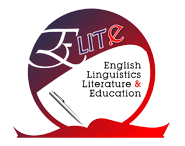Unveiling the Role of Grammar Mastery: How Sentence Structure, Verb Usage, And Subject-Verb Agreement Shape Tenses Proficiency in English Learning
 Abstract views: 57
,
Abstract views: 57
,
 PDF downloads: 44
PDF downloads: 44
Abstract
: This study looks at how well elementary school children can use language. It focuses on four main areas are basic sentence structure, proper verb use, subject-verb agreement, and the use of tenses. Since grammar is such an important part of teaching English, especially to elementary school teachers, the study's goals are to find out how well students are doing and how these skills relate to each other. A descriptive correlational method was used with a quantitative technique, and 117 bilingual students took part. A questionnaire was used to collect data, and Structural Equation Modeling-Partial Least Squares (SEM-PLS) was used to examine it. The results show that the subjects had different levels of competence, and there were significant correlations between the four parts of grammar. Basic Sentence Structure became an important factor that affected the correct use of verbs and subject-verb agreement, which in turn affected the use of tenses. The study shows how important it is for teacher education programs to teach grammar well and stress the value of combining subject knowledge with effective teaching methods to prepare bilingual teachers for their jobs. These data show how important it is to include focused interventions in teacher training programs to make sure that future elementary school teachers have the language and teaching skills they need to teach English well.
Downloads
References
Afthanorhan, A., Awang, Z., & Aimran, N. (2020). An extensive comparison of cb-sem and pls-sem for reliability and validity. International Journal of Data and Network Science, 4(4). https://doi.org/10.5267/j.ijdns.2020.9.003
Albu, E., Dudschig, C., Warren, T., & Kaup, B. (2024). Does negation influence the choice of sentence continuations? Evidence from a four-choice cloze task. Quarterly Journal of Experimental Psychology, 77(1). https://doi.org/10.1177/17470218231158109
Albus, P., & Vogt, A. (2021). Signaling in virtual reality influences learning outcome and cognitive load. Education, T Seufert - Computers &. Elsevier. https://www.sciencedirect.com/science/article/pii/S0360131521000312
Alhothali, H. M. (2021). Inclusion of 21st century skills in teacher preparation programs in the light of global expertise. International Journal of Education and Practice, 9(1). https://doi.org/10.18488/journal.61.2021.91.105.127
Antón-Méndez, I. (2020a). The Role of Verbs in Sentence Production. Frontiers in Psychology, 11. https://doi.org/10.3389/fpsyg.2020.00189
Antón-Méndez, I. (2020b). The Role of Verbs in Sentence Production. Frontiers in Psychology, 11. https://doi.org/10.3389/fpsyg.2020.00189
Arcodia, G. F. (2023a). Tense as a Grammatical Category in Sinitic: A Critical Overview. Languages, 8(2). https://doi.org/10.3390/languages8020142
Arcodia, G. F. (2023b). Tense as a Grammatical Category in Sinitic: A Critical Overview. Languages, 8(2). https://doi.org/10.3390/languages8020142
Bardach, L., & Klassen, R. M. (2020). Smart teachers, successful students? A systematic review of the literature on teachers’ cognitive abilities and teacher effectiveness. In Educational Research Review (Vol. 30). Elsevier Ltd. https://doi.org/10.1016/j.edurev.2020.100312
Boyd, D. J., Grossman, P. L., Lankford, H., Loeb, S., & Wyckoff, J. (2009). Teacher preparation and student achievement. Educational Evaluation and Policy Analysis, 31(4). https://doi.org/10.3102/0162373709353129
Clegg, J., & Milligan, L. O. (2021). Multilingual learning and language-supportive teaching in Rwandan learning materials. Multilingual Learning and Language Supportive Pedagogies in Sub-Saharan Africa, 201–227. https://doi.org/10.4324/9781003028383-14
Corcoran, R. P., & O’Flaherty, J. (2022). Social and emotional learning in teacher preparation: Pre-service teacher well-being. Teaching and Teacher Education, 110. https://doi.org/10.1016/j.tate.2021.103563
Dash, G., & Paul, J. (2021). CB-SEM vs PLS-SEM methods for research in social sciences and technology forecasting. Technological Forecasting and Social Change, 173. https://doi.org/10.1016/j.techfore.2021.121092
Deniz, N. D., Bakay, Ö., & Kurt, D. (2023). Mismatch Asymmetry in English Subject-Verb Agreement. Dilbilim Arastirmalari Dergisi, 34(1), 1–26. https://doi.org/10.18492/dad.1181172
Dündar-Coecke, S., Tolmie, A., & Schlottmann, A. (2020). Children’s reasoning about continuous causal processes: The role of verbal and non-verbal ability. British Journal of Educational Psychology, 90(2). https://doi.org/10.1111/bjep.12287
Enesi, M., Strati, E., & Trifoni, A. (2023). Alternative grammar teaching vs. traditional grammar teaching in Albanian tertiary education. International Journal of Education and Practice, 11(2). https://doi.org/10.18488/61.v11i2.3337
Fishman, A. (2023). Hebrew copulative perception verbs. Linguistics, 61(4). https://doi.org/10.1515/ling-2022-0108
Goldin, M., Otero, J. C. L., & Hur, E. (2023). How frequent are these verbs? An exploration of lexical frequency in bilingual children’s acquisition of subject-verb agreement morphology. Isogloss, 9(2). https://doi.org/10.5565/rev/isogloss.194
Guo, L., & Wang, J. (2020). English tense teaching in junior high school based on prototype theory—taking the simple present tense as an example. Theory and Practice in Language Studies, 10(9). https://doi.org/10.17507/tpls.1009.09
Hair, J., & Alamer, A. (2022). Partial Least Squares Structural Equation Modeling (PLS-SEM) in second language and education research: Guidelines using an applied example. Research Methods in Applied Linguistics, 1(3). https://doi.org/10.1016/j.rmal.2022.100027
Hair, J. F., Risher, J. J., Sarstedt, M., & Ringle, C. M. (2019). When to use and how to report the results of PLS-SEM. In European Business Review (Vol. 31, Issue 1, pp. 2–24). Emerald Group Publishing Ltd. https://doi.org/10.1108/EBR-11-2018-0203
Hair, J., Hollingsworth, C. L., Randolph, A. B., & Chong, A. Y. L. (2017). An updated and expanded assessment of PLS-SEM in information systems research. Industrial Management and Data Systems, 117(3). https://doi.org/10.1108/IMDS-04-2016-0130
Hu, Y. H., Asistido, R. L., & Villanueva, M. J. O. (2021). Influencing variables and implications in the teacher-student relationships. European Journal of Educational Research, 10(3), 1317–1327. https://doi.org/10.12973/EU-JER.10.3.1317
Jessen, A., Schwarz, L., & Felser, C. (2021). Gradience in subject-verb number agreement: Can bilinguals tune in? Applied Psycholinguistics, 42(6). https://doi.org/10.1017/S0142716421000357
Kantola, L., van Gompel, R. P. G., & Wakeford, L. J. (2023). The head or the verb: Is the lexical boost restricted to the head verb? Journal of Memory and Language, 129. https://doi.org/10.1016/j.jml.2022.104388
Köhler, R., Altmann, G., & Piotrowski, R. G. (2005). Probabilistic grammar Probabilistische Grammatik. Quantitative Linguistik / Quantitative Linguistics. https://doi.org/10.1515/9783110155785.4.292
Legate, A. E., Hair, J. F., Chretien, J. L., & Risher, J. J. (2023). PLS-SEM: Prediction-oriented solutions for HRD researchers. Human Resource Development Quarterly, 34(1). https://doi.org/10.1002/hrdq.21466
Leijen, Ä., Malva, L., Pedaste, M., & Mikser, R. (2022). What constitutes teachers’ general pedagogical knowledge and how it can be assessed: A literature review. Teachers and Teaching: Theory and Practice, 28(2). https://doi.org/10.1080/13540602.2022.2062710
Ma, Y., & Vanek, N. (2024). First Language Lexical Attrition in a First Language Setting: A Multi-Measure Approach Testing Teachers of English. Journal of Psycholinguistic Research, 53(2). https://doi.org/10.1007/s10936-024-10068-7
Mathwin, K., Chapparo, C., & Challita, J. (2024). Handwriting Accuracy of Beginning Writers and Its Impact on the Readability of Their Sentences. Journal of Occupational Therapy, Schools, and Early Intervention. https://doi.org/10.1080/19411243.2024.2315582
Moorhouse, B. L. (2024). Beginning and first-year language teachers’ readiness for the generative AI age. Computers and Education: Artificial Intelligence, 6. https://doi.org/10.1016/j.caeai.2024.100201
Müller, H. G., & Schroeder, C. (2024). On the influence of the first language on orthographic competences in German as a second language: a comparative analysis. Applied Linguistics Review, 15(2). https://doi.org/10.1515/applirev-2020-0145
Packard, G., Berger, J., & Boghrati, R. (2023). How Verb Tense Shapes Persuasion. Journal of Consumer Research, 50(3). https://doi.org/10.1093/jcr/ucad006
Rathert, S., & Cabaroğlu, N. (2020). Impact of bilingual practice on EFL learners’ self-efficacy. Journal of Language and Linguistic Studies, 16(2), 738–756. https://doi.org/10.17263/JLLS.759288
Ruivivar, J., & Collins, L. (2022). Grammar for Speaking. The Routledge Handbook of Second Language Acquisition and Speaking, 215–228. https://doi.org/10.4324/9781003022497-19
Rustipa, K., Yulistiyanti, Mulatsih, S., & Pukan, E. O. (2023). Tenses Choice and Rhetorical Pattern of Unpublished Scientific Articles written by Non-Native English Speaker Student Teachers. International Journal of Instruction, 16(2). https://doi.org/10.29333/iji.2023.16250a
Sagarra, N., & Rodriguez, N. (2022). Subject–Verb Number Agreement in Bilingual Processing: (Lack of) Age of Acquisition and Proficiency Effects. Languages, 7(1). https://doi.org/10.3390/languages7010015
Tafazoli, D., & Meihami, H. (2023). Narrative inquiry for CALL teacher preparation programs amidst the COVID-19 pandemic: language teachers’ technological needs and suggestions. Journal of Computers in Education, 10(1). https://doi.org/10.1007/s40692-022-00227-x
Truong, T. N. N. (2022). Psychometric Properties of Self-Regulated Learning Strategies in Learning English Grammar and English Grammar Self-Efficacy Scales. Frontiers in Education, 7. https://doi.org/10.3389/feduc.2022.801570
Truong, T. N. N., Noordin, N., Ismail, L., & Yahya, Y. (2022). Revisiting Views of Grammar and Grammar Learning Strategy Use: A Multiple Case Study in Vietnam. Language Value, 15(1). https://doi.org/10.6035/languagev.6124
Vural, A. Ö., Kuruoğlu, G., & Alptekin, K. (2022). Grammatical Processing in Schizoprenia: Analysis on Sentence Structure. Psycholinguistics , 31(2). https://doi.org/10.31470/2309-1797-2022-31-2-95-115
Wang, H., Lu, S., & Liu, Y. (2022). Missing data imputation in PLS-SEM. Quality and Quantity, 56(6). https://doi.org/10.1007/s11135-022-01338-4
Wu, T., Wang, M., Xi, Y., & Zhao, Z. (2024). Intent recognition model based on sequential information and sentence features. Neurocomputing, 566. https://doi.org/10.1016/j.neucom.2023.127054
Yang, Y. (2022). Structured Written Analysis-Materials. Learning & Education, 10(7), 181. https://doi.org/10.18282/l-e.v10i7.3001
The journal uses an Open Access policy under a Creative Commons Attribution-NonCommercial 4.0 International License. Authors who publish with this journal agree to the following terms:
- Authors retain copyright and grant the journal right of first publication with the work simultaneously licensed under a Creative Commons Attribution License that allows others to share the work with an acknowledgment of the work's authorship and initial publication in this journal.
- Authors are able to enter into separate, additional contractual arrangements for the non-exclusive distribution of the journal's published version of the work (e.g., post it to an institutional repository or publish it in a book), with an acknowledgment of its initial publication in this journal.
- Authors are permitted and encouraged to post their work online (e.g., in institutional repositories or on their website) prior to and during the submission process, as it can lead to productive exchanges, as well as earlier and greater citation of published work.
















